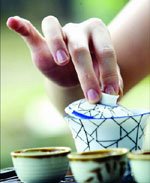Lu Yu (陆羽), known as the “God of Tea” (茶神), or the “Tea Saint” (茶圣), was Tang Dynasty’s most famous tea scholar. Before his time, there were no tea books, and just a few, scant fragments of information on tea and a few tea poems from the Jin Dynasty. But he wrote “The Classic of Tea” and thereby codified the tea rite. He laid out on 3 scrolls the knowledge of tea at that time.
His book had ten chapters: Chapter 1 – Origins, Chapter 2 – Tea Utensils, Chapter 3 – Tea Production, Chapter 4 – Tea Wares, Chapter 5 – Brewing, Chapter 6 – Drinking, Chapter 7 – Matters About Tea, Chapter 8 – Tea Producing Areas, Chapter 9 – Summary, Chapter 10 – Plan of the Book
His tea book became the outline for many later tea books of the Tang, Song, Yuan, Ming, and Qing eras. And many tea scholars have written commentaries on his writings, and quoted from his original work. Today, the Classic of Tea or Cha Jing is still important for understanding Tea.
There is a lot of information on Lu Yu’s life – recorded in various other books, like the “Xin Tang Shu”. Basically, what we know about his life is that he was an orphan. And a Buddhist scholar took him in. Then, he was raised at the Long Gai Temple (龙盖寺) in present-day Tian Men County, Hubei province. Though, later, he had no interest in studying Buddhism.
Because he had no name, the Book of Changes (易经) was consulted, and his name was divined. His name comes from hexagram 53. So he was given the surname Lu (姓陆), and name of Yu (名羽). And his pen-name was Hong Jian (字鸿渐).
Here is the original Chinese:
渐卦,第五十三
上九,鸿渐于陆,其羽可用为仪,吉。
Hexagram 53 reads:
“The wild swan gradually comes to the land. The feathers can be used for ceremonial (dress). Auspicious.
Lu Yu lived in southern China, near tea-producing areas. So he was able to have an intimate knowledge and understanding of Tea.
Lu Yu became a scholar in life, and traveled around China to many places. So he was quite well-educated and knowledgeable about the affairs in Tang China. Besides tea books, he wrote many other non-tea related books. But he is most famous for The Classic of Tea.
A Brief Timeline of Events in Lu Yu’s Life:
733 CE Lu Yu was born on an autumn day in present-day Tian Men County, Hubei province.
738 CE Lu Yu started to study Chinese characters at the age of 6. He is reputed to practice writing by tracing with a stick while riding on the back of an ox.
740 CE Lu Yu is given the task of preparing tea for his master; at the age of 8.
749 CE At 17, he learned to pick tea.
765 CE Lu Yu produces the first draft of the Classic of Tea.
775 CE Lu Yu revises the Classic of Tea on 3 scrolls.
780 CE The Classic of Tea is carved onto printing blocks. From this point on, the Classic of Tea can be mass-printed.
804 CE On a winter day, Lu Yu takes sick and dies at the age of 72.
Notes: It is Chinese custom to count the year you are born as year one. So to Chinese, a newborn is already 1 year old.
Immortal's Palm Tea
-
by STEVEN D. OWYOUNG
AUTHOR'S NOTE: *This essay is dedicated to Frank Hadley Murphy, author of
The Spirit of Tea, for his kind introduction to the poet Li B...
14 years ago


4 comments:
Yes, there has been one translation of Lu Yu's Classic of Tea into English - by Francis Ross Carpenter. But it is a dated translation. With Chinese words transliterated in the Wade-Giles system, which makes it difficult to understand. It's just a simple translation. And it loses most of the real meaning behind the original Chinese text. But, it's the only English translation so far, so I guess it's better than nothing.
There is also an excellent summary and explanation of the Classic of Tea in Sen Shoshitsu's book "The Japanese Way of Tea".
Here is a Chinese version on my web page, encoded in Chinese Traditional Big-5:
http://geocities.com/niisonge/chajing.html
Actually, that can be done. In fact, I was planning on writing a better translation of the Cha Jing - along with an explanation - which would help to better understand Tang Dynasty tea customs.
Mariage Freres does a french translation, maybe we should lobby for an english version too :)
Post a Comment